5 Key Elements of a Master Data Management Strategy


Key Takeaways:
Are you struggling with duplicate records, mismatched IDs, or supplier data scattered across multiple systems?
A master data management (MDM) strategy can fix that by turning fragmented information into a single, trusted source of truth.
In this post, we’ll break down the five key elements every MDM strategy needs to succeed.
Let’s dive in!
Every MDM initiative must begin with a precise definition of its business purpose.
Without clear objectives, there’s no way of knowing if your strategy is paying off, how to improve it, or what to include in it in the first place.
On top of that, failing to link MDM to business value could jeopardize stakeholder buy-in and limit resource allocation.
Malcolm Hawker, Chief Data Officer at Profisee, agrees.
He emphasizes that failing to define ROI often leads to the deprioritization of MDM programs, but defining it remains an ongoing struggle for data leaders.
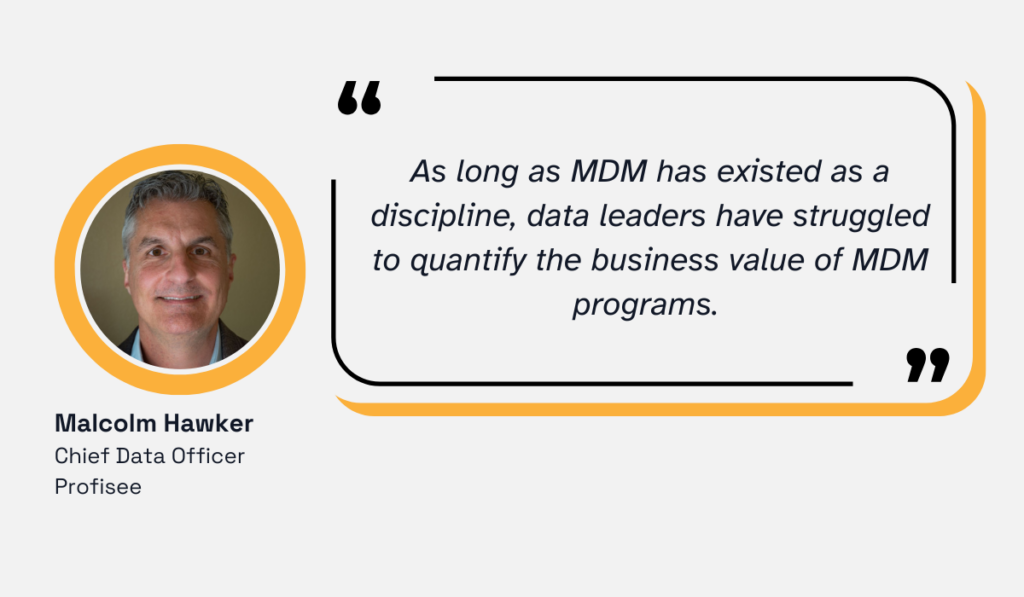
Illustration: Veridion / Quote: Profisee
So, to secure leadership support and sufficient resources for your MDM initiatives, your program must serve a clear purpose and deliver measurable business value.
For example, some common procurement objectives include faster supplier onboarding, reduced compliance risks, and better spend analytics.
Considering the objectives you want to achieve is the first step in building a focused and results-driven MDM strategy.
After you nail this down, you should set clear key performance indicators (KPIs) for each objective.
Amy Cooper, Principal Data Management Strategist with Dun & Bradstreet, says this is key to tracking your progress.
However, she also warns that about 90% of companies aren’t doing this just yet, and the few that do aren’t even using the right KPIs.
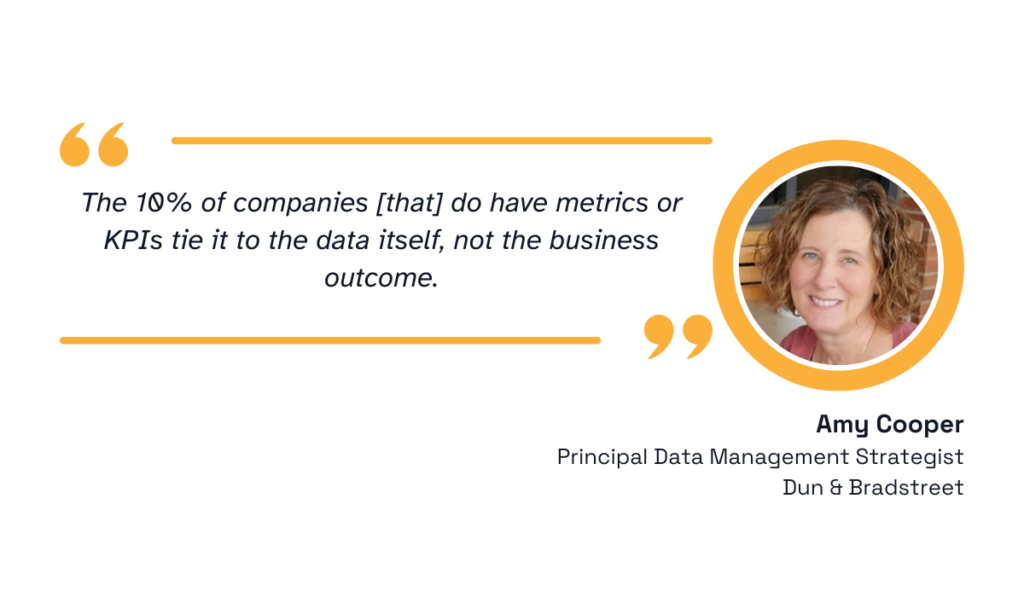
Illustration: Veridion / Quote: DATAVERSITY
Cooper’s advice is to focus on the KPIs that communicate the business value of an objective or achievement.
You can still set metrics that pertain exclusively to data, such as data accuracy and duplicate record rates.
But, for the best results, couple them with metrics that link these improvements to tangible business outcomes.
Need some examples to get started?
Here are several KPIs you could use to measure the progress toward the aforementioned procurement objectives:
| Faster Supplier Onboarding | Reduced Compliance Risks | Better Spend Analytics |
| Average supplier onboarding time | Percentage of suppliers with up-to-date regulatory info | Cost savings from strategic sourcing |
| Operational delay incidents | Compliance violation incidents | Maverick spend rate |
| Time to first transaction | Number of non-compliant suppliers | Supplier consolidation rate |
If we analyze these KPIs more deeply, we’ll see that they all tie back to business value.
For example, a higher supplier consolidation rate could indicate reduced administrative overhead, improved supplier relationships, and potential procurement cost savings through bulk discounts.
You should set similar KPIs for your own MDM initiatives.
In fact, this should be the first thing you do, since objectives and KPIs should guide your entire strategy.
They’ll also determine how best to engage stakeholders.
Involving all relevant stakeholders early is key to designing a strategy that works in real-world environments.
Since every department both contributes to and relies on master data, their needs, workflows, and access requirements must be understood from the outset.
Also, giving those responsible for executing the strategy a voice in its design increases the likelihood of broad buy-in.
This matters because MDM is not just an IT initiative, but a cross-functional effort that impacts every department.
Cooper says you should start by understanding the goals of each unit and how they measure success.
Here’s an example of what those goals might look like:

Source: Veridion
As you can see, the goals could vary significantly from one department to another.
This makes it challenging to create an MDM strategy that supports everyone in achieving their unique goals.
For instance, it can be difficult to reduce system complexity, as IT aims to do, while also adding the features other departments need to meet their own goals, like shortening closing cycles or improving supplier performance.
The best way to approach this is to discuss potential solutions with subject matter experts.
SpendMatters even suggests establishing formal steering committees to bring together leaders from different areas to strengthen cross-functional collaboration and secure buy-in.
A committee might look like this:
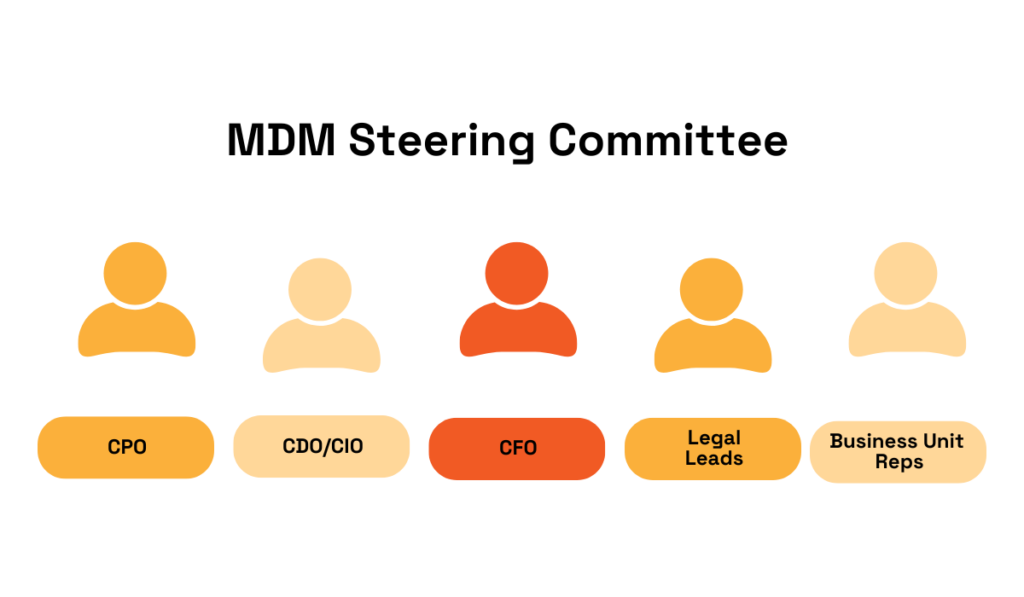
Source: Veridion
Once you gather all relevant stakeholders, you should set clear goals, establish who owns which data, and discuss the internal resistance you might expect.
The reality is, new processes, governance methods, and systems rarely gain acceptance without pushback.
However, talking to department heads and executives can help you identify potential obstacles before they escalate.
You should use their input to develop a change management plan, which involves:
The most important thing to consider is what type of training teams need to adjust to the changes ahead.
Also, assigning data champions can help you foster adherence to new standards across departments.
Formalized data governance is the third key element of an MDM strategy. It implies creating an official governance framework for managing master data consistently.
Without it, you’re risking inconsistent entries and conflicting data definitions, which can erode trust in your data and lead to costly decision-making errors.
You surely want to avoid this.
So, how can you create a governance framework tailored to your needs?
Well, you should start by understanding the core components of these frameworks.
According to Atlan, a data governance solution, every data governance framework should encompass four pillars: people, process, technology, and policy.
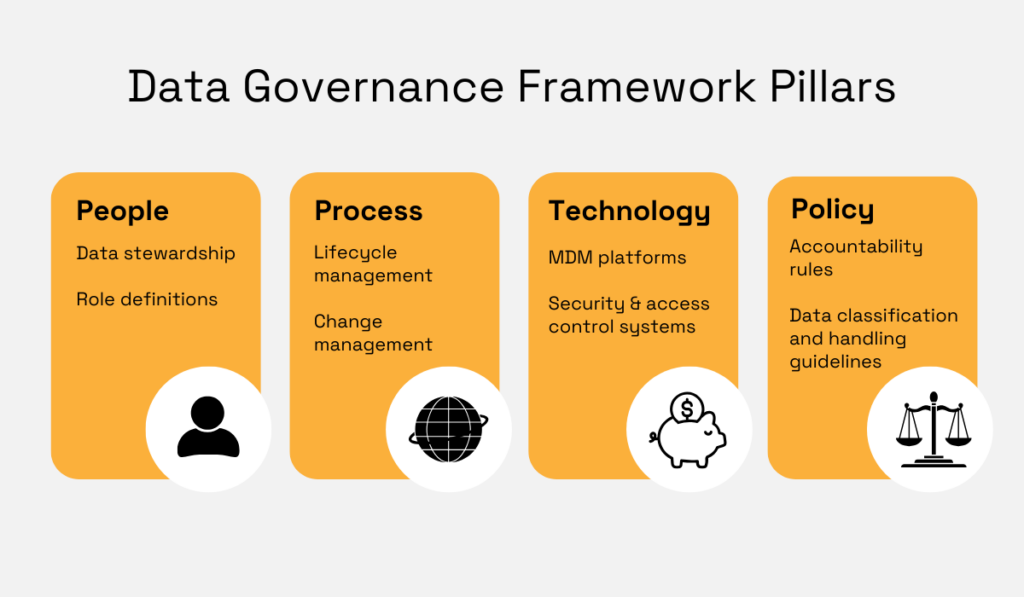
Illustration: Veridion / Data: Atlan
Here is a more detailed walkthrough of each pillar:
To create an adequate governance framework, you need to clearly define each pillar to eliminate doubts.
For instance, when defining the People pillar, you might:
Everyone should know exactly what they are and aren’t responsible for.
However, keep in mind that a governance framework is not a one-and-done effort.
Your needs and available solutions will both change and evolve, so you must occasionally review your framework and adjust it accordingly.
Even large, well-established organizations, like JPMorgan, do this regularly.
Despite already having robust data governance mechanisms in place, JPMorgan recognized the need to improve cross-enterprise data visibility and centralize its data.
Below are some challenges they faced:

Source: AIMultiple
That’s why the company decided to adopt data mesh architecture and deploy a data mesh catalog.
The new architecture allows them to distribute data across business units, while the catalog enables cross-enterprise visibility.
This is just one example of how even the most mature organizations must continuously adapt their governance approach to keep pace with evolving data needs.
It also shows why it’s worth continuously working on your own data governance.
One of the main prerequisites for MDM is unifying fragmented data into one consistent, trusted source of truth.
Without this, a successful MDM strategy is impossible because its foundation of centralized, reliable data does not exist.
On top of that, reports like this one from XPLM show that data silos prevent cross-departmental exchange in the majority (76%) of companies.

Illustration: Veridion / Data: XPLM
This directly conflicts with MDM’s goal of making the same accurate, up-to-date data available to every department, and hints at other various operational issues siloed data can cause.
In the same survey, as many as 42% of respondents said that the number of data silos in their companies has increased in recent years, making the problem even more pervasive.
If this is the case in your company, too, consolidating scattered data will not just enable MDM, but also improve your operational harmony and yield better results in the long run.
This should be both an essential building block and a key objective of your strategy.
And in case you’re wondering if and just how siloed your data is, look for some of the common signs, such as:
If you’re experiencing these issues, siloed data is the likely culprit.
To mitigate them and centralize your data, consider using dedicated MDM platforms or APIs.
Some options include SAP Master Data Governance, Reltio, and the AI-first Tamr.
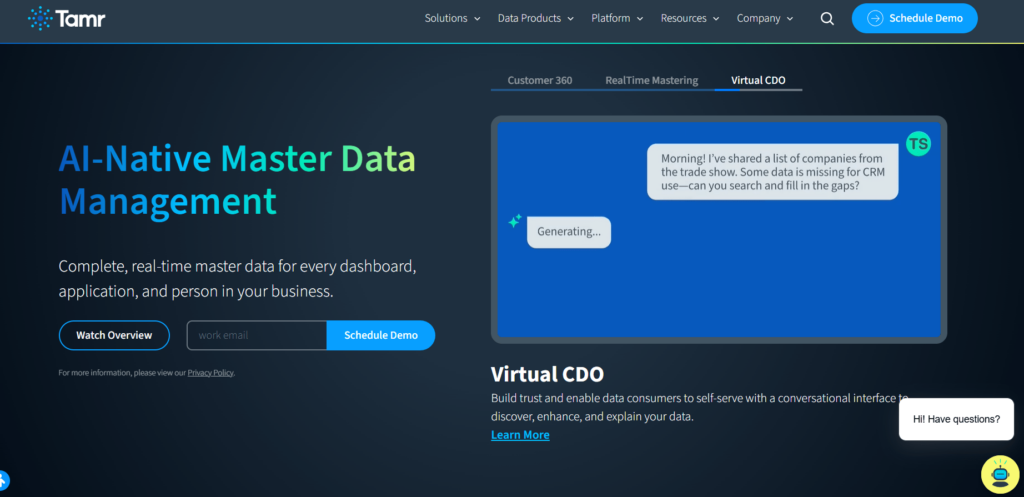
Source: Tamr
Many MDM platforms can connect with any data source, allowing you to manage all types of data across systems and databases.
Today, many also come with AI-powered features, allowing for easier and more accurate data management.
For instance, with Tamr, you can simply describe your data requirements and give feedback on the mastered data using natural language.
All in all, data integration does not have to be complex or time-consuming anymore. It just takes the right tools to streamline and simplify the process.
Mastering data management is not a one-off project.
Real-world conditions change over time, like when your suppliers move to new addresses or when products get updates.
Your master data should reflect these changes, which means you should regularly test and monitor it.
But exactly how often should you do this?
Atlan says this depends on how critical specific data is to your business and how often it changes.
For instance, your most critical data should be monitored in real time, less critical yet dynamic data tested daily, and relatively static data reviewed monthly.
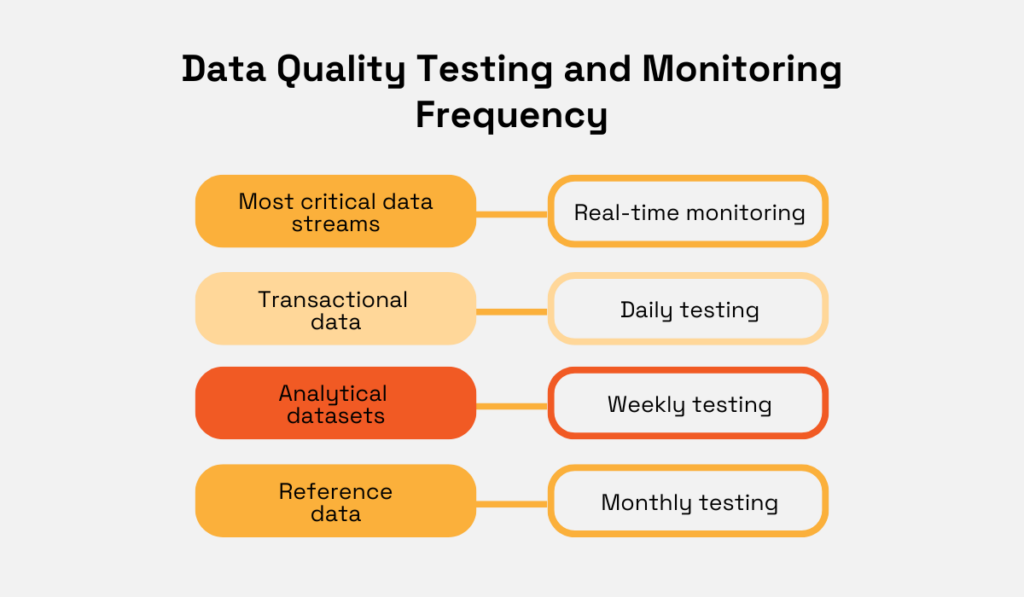
Illustration: Veridion / Data: Atlan
Once you review your data, you might spot errors or inconsistencies and need to apply corrective practices. These can include data deduplication, validation, and enrichment.
Deduplication involves removing duplicate data, validation refers to ensuring that data is consistent, accurate, and complete, and enrichment is adding new information to enhance existing data.
These processes are critical for ensuring data quality, but can be very time-consuming when handled manually.
To reduce manual work, companies should adopt the right technology.
One outstanding solution is Veridion, our data enrichment platform.
Veridion collects data on more than 120 million global companies from various sources, ranging from company websites and reports to news outlets.
The data is updated weekly to ensure freshness and completeness.
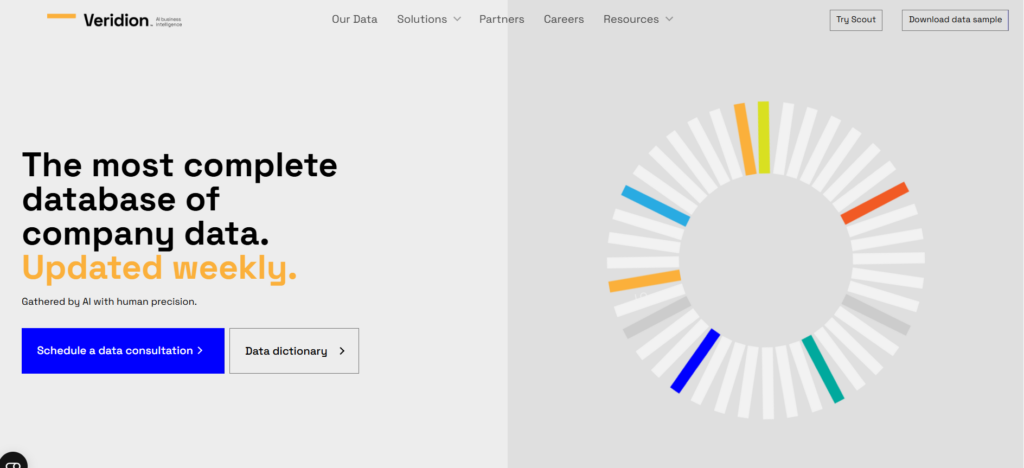
Source: Veridion
Veridion acts as a third-party source of company data, eliminating the need to rely on biased sources, such as suppliers’ self-reports, or to collect and update data manually.
It also comes equipped with other data management capabilities, including automated, AI-powered deduplication.
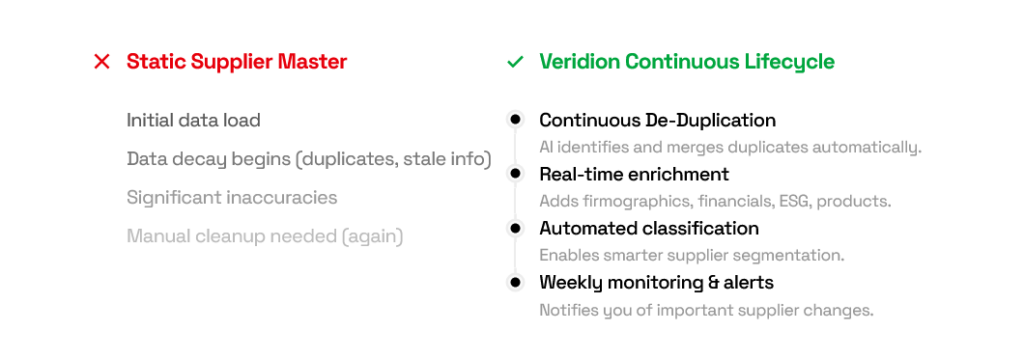
Source: Veridion
These and other features allow procurement teams to focus on more strategic tasks while still equipping them with accurate, unbiased data.
This is key to making informed procurement decisions in the long run.
In this post, we explored the five key elements of a successful master data management strategy.
You now know how to address the main prerequisites, from setting clear objectives to maintaining ongoing data quality.
The next step is to start designing your strategy alongside relevant stakeholders.
Gather their input, involve them in decisions, and make them feel heard.
With collaboration, clear goals, and consistent execution, you’ll be well on your way to building an MDM strategy that delivers lasting value.
The sooner you start, the sooner you’ll see the benefits.